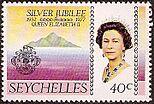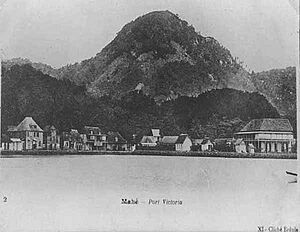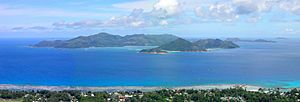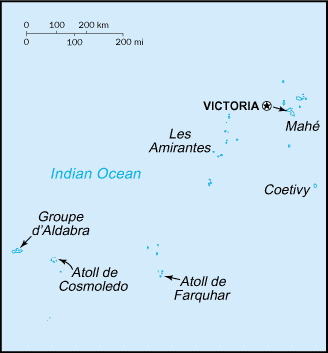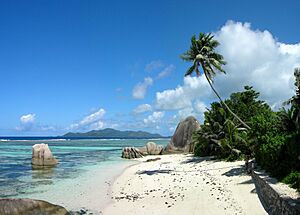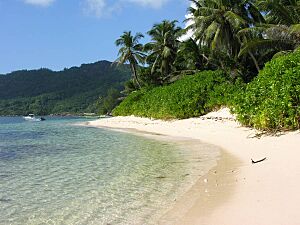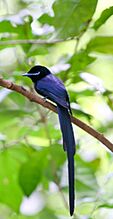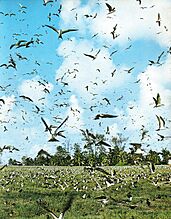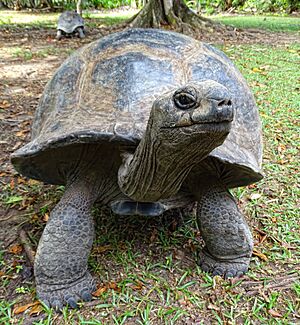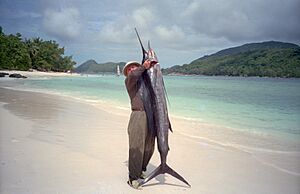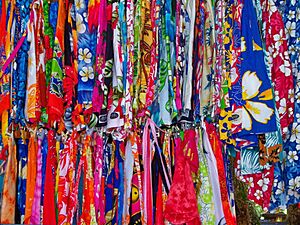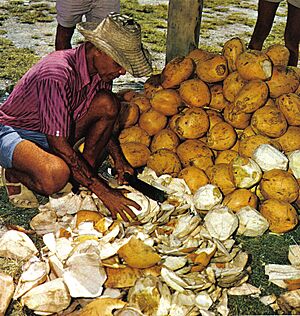Seychelles facts for kids
Quick facts for kids
Republic of Seychelles
|
|
|---|---|
|
|
|
|
Anthem: Koste Seselwa
Join together all Seychellois |
|
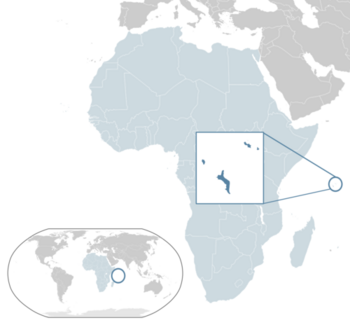
Location of Seychelles (dark blue)
– in Africa (light blue & dark grey) |
|
| Capital and largest city
|
Victoria 4°37′S 55°27′E / 4.617°S 55.450°E |
| Official languages | |
| Ethnic groups | Seychellois Creoles others |
| Religion
(2022)
|
|
| Demonym(s) |
|
| Government | Unitary presidential republic |
| Wavel Ramkalawan | |
| Ahmed Afif | |
| Legislature | National Assembly |
| Independence
from the United Kingdom
|
|
|
• Independence declared
|
29 June 1976 |
| Area | |
|
• Total
|
457 km2 (176 sq mi) (181st) |
|
• Water (%)
|
negligible |
| Population | |
|
• 2024 estimate
|
130,523 (200th) |
|
• Density
|
262.3/km2 (679.4/sq mi) (67th) |
| GDP (PPP) | 2023 estimate |
|
• Total
|
|
|
• Per capita
|
|
| GDP (nominal) | 2023 estimate |
|
• Total
|
|
|
• Per capita
|
|
| Gini (2018) | 32.1 medium |
| HDI (2022) | very high · 67th |
| Currency | Seychellois rupee (SCR) |
| Time zone | UTC+04:00 (SCT) |
| Driving side | left |
| Calling code | +248 |
| ISO 3166 code | SC |
| Internet TLD | .sc |
Seychelles is an African country located in the Indian Ocean. Its capital city is Victoria. The official languages are Seychellois Creole, English, and French.
This island nation lies east of the African continent. The islands of Madagascar and Mauritius are to its south. Seychelles is made up of 115 islands. Most of its people are a mix of freed slaves from Africa and Madagascar, along with European settlers. They make up about 90% of the population. There are also smaller groups of immigrants from Europe, China, and India. Most people in Seychelles are Roman Catholics.
Other nearby island countries include Zanzibar to the west. To the south are Mauritius, Rodrigues, Agalega, and Réunion. Comoros and Mayotte are to the southwest. Seychelles has a population of about 130,523 people. It has the smallest population of any African country.
Contents
History of Seychelles

Seychelles was not inhabited by people until the 18th century. That's when Europeans arrived, bringing people from India and enslaved Africans. The islands were a British colony from 1814 until they became independent in 1976. Even though there were no indigenous people originally, the islanders today have their own special Creole heritage.
Early Discoveries and French Control
For most of history, Seychelles was empty of people. However, some studies suggest that Asian sailors might have visited the islands long ago. Tombs found on Silhouette Island, visible until 1910, might belong to Maldivian and Arab traders.
Vasco da Gama and his fleet discovered the Seychelles on March 15, 1503. His ships passed close to an island, probably Silhouette Island. The next day, they saw Desroches Island. Later, the Portuguese mapped seven islands and called them The Seven Sisters. The first recorded landing was in January 1609. This was by the crew of the Ascension from the British East India Company.
The islands were a stop for trade ships between Africa and Asia. Pirates sometimes used them too. Then, the French started to take control in 1756. Captain Nicholas Morphey placed a special stone on Mahé to mark French ownership. The islands were named after Jean Moreau de Séchelles, who was the French Minister of Finance.
In August 1770, a French ship brought 28 people to Ste. Anne Island. These included 15 white men and 13 enslaved men and women from Africa and India.
British Rule and Independence
During a war in 1794, a British ship arrived at Mahé. The French administrator, Jean Baptiste Quéau de Quincy, decided not to fight. Instead, he made a deal for the islands to be neutral. This meant the settlers would be safe.
Britain fully took control when Mauritius surrendered in 1810. This was made official in 1814 by the Treaty of Paris. Seychelles became a separate British colony in 1903. Elections were held in 1966 and 1970.
Seychelles gained independence from the United Kingdom in 1976. It became a republic and joined the Commonwealth. In the 1970s, Seychelles was a popular place for famous people. In 1977, France Albert René took power from the first president, James Mancham. René wanted to reduce the country's reliance on tourism. He said he wanted "to keep Seychelles for the Seychellois."
A new constitution in 1979 made Seychelles a one-party state. This lasted until 1991.
In the 1980s, there were several attempts to overthrow President René. Some of these were supported by South Africa. In 1981, a group of mercenaries tried to take over. There was a gunfight at the airport. Most of them escaped on a hijacked plane.
In 1986, another coup attempt happened. President René asked India for help. An Indian naval ship arrived to help stop the coup.
A new constitution was approved in 1993.
In 2012, Seychelles promised to protect 30% of its marine waters. This is a large area of 1.35 million square kilometers.
In January 2013, a tropical cyclone Felleng caused heavy rain, floods, and landslides. Many houses were destroyed.
For a long time, the same political party held the presidency. But in the October 2020 Seychellois general election, the opposition party won. Wavel Ramkalawan became the first president not from the United Seychelles party.
In 2023, Seychelles announced it was finishing its marine spatial plan. This plan helps manage its ocean area. It will be the second largest ocean area protected in this way, after Norway. This supports its blue economy, which focuses on sustainable use of ocean resources.
Geography of Seychelles
Seychelles is an island nation in the Somali Sea part of the Indian Ocean. It is northeast of Madagascar and about 1,600 kilometers (860 nautical miles) east of Kenya. The country's Constitution lists 155 named islands. Seven more islands have been created by reclaiming land from the sea. Most of the islands are not inhabited. Many are protected as nature reserves. Seychelles' largest island, Mahé, is about 835 nautical miles (1,546 km) from Mogadishu, Somalia's capital.
A group of 44 islands are called the inner islands. They are mostly granite and two are coral. These islands are in the shallow waters of the Seychelles Bank. They cover 244 square kilometers (94 sq mi). This is 54% of Seychelles' total land area. They are home to 98% of the country's population.
The islands are divided into groups. There are 42 granite islands. These include Mahé, Praslin, Silhouette, and La Digue.
There are two coral sand cays north of the granite islands: Denis and Bird. South of the granite islands are two coral islands: Coëtivy and Platte.
There are 29 coral islands in the Amirantes group. These are west of the granite islands. They include Desroches and Alphonse.
There are 13 coral islands in the Farquhar Group. These are south-southwest of the Amirantes. They include Farquhar Atoll and Providence Atoll.
There are 67 raised coral islands in the Aldabra Group. These are west of the Farquhar Group. They include Aldabra Atoll, Assumption Island, and Cosmoledo Atoll.
In addition to these 155 islands, there are 7 islands made by reclaiming land. These are Ile Perseverance, Ile Aurore, Romainville, Eden Island, Eve, Ile du Port, and Ile Soleil.
Some islands have changed over time. South Island, African Banks, has been worn away by the sea. At St Joseph Atoll, Banc de Sable and Pelican Island have also eroded. Grand Carcassaye and Petit Carcassaye have joined together.
Climate of Seychelles
The climate in Seychelles is very humid. It is a tropical rain forest climate. The temperature does not change much during the year. On Mahé, temperatures range from 24 to 30 °C (75 to 86 °F). Rainfall is about 2,900 mm (110 in) per year in Victoria. It can be up to 3,600 mm (140 in) on mountain slopes. Other islands get a bit less rain.
The coolest months are July and August. The average low temperature is about 24 °C (75 °F). From May to November, steady winds blow from the southeast. This is the most pleasant time of year. The hot months are from December to April, with high humidity (80%). March and April are the hottest, but the temperature rarely goes above 31 °C (88 °F). Most islands are outside the cyclone belt, so strong winds are rare.
| Climate data for Victoria (Seychelles International Airport) | |||||||||||||
|---|---|---|---|---|---|---|---|---|---|---|---|---|---|
| Month | Jan | Feb | Mar | Apr | May | Jun | Jul | Aug | Sep | Oct | Nov | Dec | Year |
| Mean daily maximum °C (°F) | 29.8 (85.6) |
30.4 (86.7) |
31.0 (87.8) |
31.4 (88.5) |
30.5 (86.9) |
29.1 (84.4) |
28.3 (82.9) |
28.4 (83.1) |
29.1 (84.4) |
29.6 (85.3) |
30.1 (86.2) |
30.0 (86.0) |
29.8 (85.6) |
| Daily mean °C (°F) | 26.8 (80.2) |
27.3 (81.1) |
27.8 (82.0) |
28.0 (82.4) |
27.7 (81.9) |
26.6 (79.9) |
25.8 (78.4) |
25.9 (78.6) |
26.4 (79.5) |
26.7 (80.1) |
26.8 (80.2) |
26.7 (80.1) |
26.9 (80.4) |
| Mean daily minimum °C (°F) | 24.1 (75.4) |
24.6 (76.3) |
24.8 (76.6) |
25.0 (77.0) |
25.4 (77.7) |
24.6 (76.3) |
23.9 (75.0) |
23.9 (75.0) |
24.2 (75.6) |
24.3 (75.7) |
24.0 (75.2) |
23.9 (75.0) |
24.4 (75.9) |
| Average precipitation mm (inches) | 379 (14.9) |
262 (10.3) |
167 (6.6) |
177 (7.0) |
124 (4.9) |
63 (2.5) |
80 (3.1) |
97 (3.8) |
121 (4.8) |
206 (8.1) |
215 (8.5) |
281 (11.1) |
2,172 (85.6) |
| Average precipitation days (≥ 1.0 mm) | 17 | 11 | 11 | 14 | 11 | 10 | 10 | 10 | 11 | 12 | 14 | 18 | 149 |
| Average relative humidity (%) | 82 | 80 | 79 | 80 | 79 | 79 | 80 | 79 | 78 | 79 | 80 | 82 | 79.8 |
| Mean monthly sunshine hours | 153.3 | 175.5 | 210.5 | 227.8 | 252.8 | 232.0 | 230.5 | 230.7 | 227.7 | 220.7 | 195.7 | 170.5 | 2,527.7 |
| Source 1: World Meteorological Organization | |||||||||||||
| Source 2: National Oceanic and Atmospheric Administration | |||||||||||||
Wildlife and Conservation Efforts
Seychelles is a world leader in protecting land for threatened species. It sets aside 42% of its land for conservation. Like many island ecosystems, Seychelles lost some of its biodiversity when humans first settled there. Most of the giant tortoises on the granite islands disappeared. Coastal forests were cut down. Some species, like the Seychelles chestnut-flanked white-eye and the Seychelles parakeet, became extinct. However, fewer species were lost here than on islands like Mauritius or Hawaii. This is partly because humans lived there for a shorter time.
Today, Seychelles is known for successfully protecting its plants and animals. The rare Seychelles black parrot, the country's national bird, is now protected.
The freshwater crab genus Seychellum is found only in the granite Seychelles. There are also 26 other crab species and five species of hermit crabs on the islands. From the 1500s to the mid-1800s, the Aldabra giant tortoise was hunted for food. This nearly made them extinct. Today, about 150,000 tortoises live on the Aldabra atoll. This area is a UNESCO World Heritage Site. These ancient reptiles can also be found in zoos and gardens worldwide. Their protection from poaching is managed by CITES. Breeding them in captivity has helped reduce the impact on wild populations. The granite islands of Seychelles are home to three types of Seychelles giant tortoise.
Seychelles has some of the largest seabird colonies in the world. These are especially found on the outer islands of Aldabra and Cosmoledo. On the granite islands, the biggest colonies are on Aride Island. This island has the world's largest numbers of two bird species. The sooty tern also breeds on the islands. Other common birds include the cattle egret and the fairy tern. More than 1,000 types of fish have been recorded.
The granite islands of Seychelles have about 268 types of flowering plants. About 70 (28%) of these are found nowhere else. The coco de mer is very famous. It is a type of palm tree that grows only on Praslin and nearby Curieuse islands. The jellyfish tree is found in only a few places on Mahé. This strange, old plant seems to grow only when cultivated, not in the wild. Other unique plants include Wright's gardenia, found only on Aride Island’s Special Reserve. There are also several unique types of orchid on the islands.
Seychelles has two land ecoregions: Granitic Seychelles forests and Aldabra Island xeric scrub. In 2019, the country had a perfect score of 10/10 on the Forest Landscape Integrity Index. This ranked it first globally among 172 countries.
Administrative Divisions
Seychelles is divided into twenty-five administrative regions. Eight of these districts make up the capital of Seychelles, called Greater Victoria. Another 14 districts are in the rural part of the main island of Mahé. There are two districts on Praslin and one on La Digue. These also include smaller islands nearby. The rest of the Outer Islands are not part of any district.
|
|
|
Government and Politics
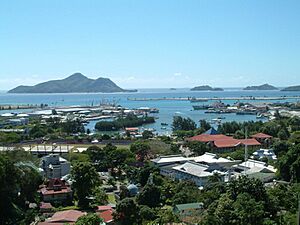
The President of Seychelles is both the head of state and the head of government. People vote for the president every five years. The president chooses and appoints the cabinet members. These choices must be approved by most of the lawmakers.
Seychelles has a single parliament called the National Assembly. It has 35 members. 26 members are chosen directly by popular vote. The other nine seats are given based on how many votes each political party gets. All members serve for five years.
The Supreme Court of Seychelles was created in 1903. It is the highest trial court in Seychelles. It also hears appeals from lower courts. The highest court in Seychelles is the Seychelles Court of Appeal. This court makes the final decisions on legal cases.
Economy of Seychelles
In the past, during the plantation era, the main exports were cinnamon, vanilla, and copra (dried coconut meat).
Today, the tourism industry employs about 30% of the workers. Even with tourism growing, farming and fishing still provide jobs for many people. Industries that process coconuts and vanilla also employ workers.
As of 2013, the main things Seychelles exports are processed fish (60%) and frozen fish (22%).
The main farm products grown in Seychelles are sweet potatoes, vanilla, coconuts, and cinnamon. These products help support the local economy. Frozen and canned fish, copra, cinnamon, and vanilla are the main goods sent to other countries.
The money used in Seychelles is the Seychellois rupee. In 2008, its value was allowed to change freely. This was done to attract more foreign investment into the country's economy.
Languages Spoken in Seychelles
French and English are official languages. Seychellois Creole is also an official language. It is a French-based creole language. It is similar to the languages spoken in Mauritius and Reunion. Seychellois Creole is the most common native language. It is also the country's national language. People often mix English words and phrases into Seychellois Creole when they speak.
Cuisine of Seychelles
The main foods in Seychelles include fish, seafood, and shellfish dishes. These are often served with rice. Fish dishes are cooked in many ways. They can be steamed, grilled, wrapped in banana leaves, baked, salted, or smoked. Curry dishes with rice are also a big part of the country's food.
Other common foods include coconut, breadfruit, mangoes, and kordonnyen fish. Dishes are often decorated with fresh flowers.
Some popular dishes include:
- Chicken dishes, like chicken curry with coconut milk.
- Coconut curry.
- Dal (lentils).
- Fish curry.
- Saffron rice.
- Fresh tropical fruits.
- Ladob, which can be a savory dish or a dessert. The dessert version has ripe plantain and sweet potatoes. It can also include cassava, breadfruit, or corossol. These are boiled with coconut milk, sugar, nutmeg, and vanilla until soft and creamy. The savory version uses salted fish, cooked similarly, but with salt instead of sugar.
- Shark chutney is made from boiled shark. It is mashed and cooked with squeezed bilimbi juice and lime. It is mixed with fried onion and spices.
- Various vegetable dishes.
Images for kids
See also
 In Spanish: Seychelles para niños
In Spanish: Seychelles para niños





